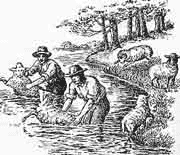
19
When the interurban railway between Dayton and Greenville, our county seat, began operating, the company reserved one day for free rides. Father decided to take me. We drove the six miles from New Harrison to Greenville in our buggy, accompanied by a neighbor, Mr. Martin. After hitching the horse on the common, we boarded the train. The ride to Dayton in the open car at what seemed like lightning speed was a thrilling experience.
On the return trip, we had the Dayton crowd, which included many factory workers. Too much liquor had made them rough and boisterous. Someone hit me on the arm with a half-filled whisky bottle, which Father seized and tossed from the train. The owner turned on him menacingly, but did not carry out his threats.
When we arrived from Dayton, I ran ahead to get the horse and buggy at the common. Two drunken men had started a fight, which quickly developed into a riot, with one hundred men or more on each side. It was Greenville versus Dayton. Hoop poles lying in piles on the grass made excellent cudgels.
By dodging this way and that I reached the buggy. Men were throwing rocks, one of which broke a spoke in the wheel. Father and Mr. Martin were helpless to do anything, and I saw little chance of escape. Two men were killed in the riot before officers of the peace eventually succeeded in restoring order. This experience made a deep impression on me.
On the way home, we three did some serious thinking.
20
"If the opportunity ever comes to you to strike at alcohol," Father said, "strike it hard!"
As a rule, the pioneer men were square, helpful, and good-intentioned, but, as I have said, there was far too much drinking. When the tavern-keeper went wild with delirium tremens somebody always came for Father. No one else could control him, but he was plastic in Father's hands. His son persisted in daring me to fight, well knowing I had Father's disapproval. One day Father overheard his taunts and said, "Thresh him, Frank." I gave him a good trouncing, with no afterclaps from Father this time.
The curse of drink finally ruined the boy's life. He had little chance in the face of his surroundings. His one redeeming quality was his fine penmanship. Father asked him to write some records in our family Bible, and I still enjoy looking at those beautifully formed letters.
At corn huskings, public sales, political meetings, and log rollings the bottle was always present, and friendly bouts all too often developed into drunken brawls. Log rollings took place in early spring when a piece of virgin forest was to be cleared. These were gala affairs, calling for neighborly co-operation. Before the appointed day, axe strokes bit into tough trunks and huge trees crashed to the ground. Workers cut the tops into stove wood and peeled off any white oak bark to be sold to the tanner. Then came the "niggering off" of the trunks by laying heavy limbs across them some fifteen feet apart. Fires were started at these points—hundreds of fires burning at once. It required constant attention to keep the blaze under control, to rub limbs across the trunks, and place new limbs if needed. This was all in preparation for the actual log rolling, when a general invitation was issued and21
everybody came. On that occasion men arranged the fifteen-foot logs in huge piles, applied the torch, and we gazed in awe as tongues of flame leaped skyward from the giant bonfire.
There was one gathering when, by common consent, drinking was forbidden. That was at barn raisings, where clear heads and steady nerves were mandatory. It was dangerous work. Flinching or dropping the heavy pike might have been fatal.
The time came when Father needed a large barn to shelter stock and protect grain. He knew he could count on his neighbors to help with the raising, just as he had helped them. Such mutual assistance lessened the privations of frontier life.
I was allowed to go to the woods with four horses and drag a large piece of hewn timber to the place where the barn was to be. Many other logs, chiefly of shellbark hickory and about sixty feet long, were brought in, together with sills, posts, and plates, that were cut in the woods.
Henry Cunningham served as our architect to lay out plans and prepare the framing. An able and well-liked carpenter, George Reck, was chosen to boss the job, chiefly because of his stentorian voice. On the day appointed, a hundred volunteers were on hand to take orders.
The first move was to place the heavy sills on a prepared foundation. Posts were carried to the corners and carefully laid, with the tenon ready to drop into the mortise when raised. The bents—entire ends and sides of the barn—were assembled and pinned together.
Next came the raising. Scores of men took their places,22
equipped with light tapering pike poles, twelve to sixteen feet long, each having an iron spike in the end.
"All together, heave," shouted Reck.
One side and one end were raised simultaneously, a man going up with each bent to fasten the pieces together with hickory pins. The process was repeated with the next two bents, tenons fitting solidly into the mortises in the same way. It was like clockwork.
After the final raising, pandemonium reigned. Some of the men lifted Father and the carpenters onto horizontal ladders, and before I knew it, I too, was in for a ride. A pair of strong arms set me up beside the others, and we were all carried in triumph down the main street through a cheering crowd. The day ended with a big dinner for all the workers, served under the trees.
